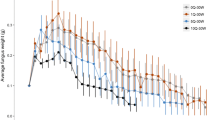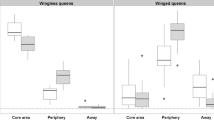Summary
-
1.
The results are described for three experiments investigating the grouping, in small observation nests, of queens of the antMyrmica rubra L.
-
2.
The first describes how a group of normal queens, without workers, establishes an egg-mass which acts as a core. Then when workers are introduced, how they gradually take over the general duties of the colony while the queens' activities are concentrated in the core.
-
3.
The second describes the behaviour of a large natural group of microgynes and workers in the observation nest. It shows that microgynes, like normal queens, establish a core. Reduction in the worker population does not seriously affect the colony's structure.
-
4.
The third experiment describes what happens when normal queens and microgynes are grafted (a process of gradual introduction) into small colonies of the other type. Contrary to expectation the newly grafted queens, of whichever type, monopolized the core at the expense of the familiar queens.
-
5.
The importance of the core for the activity and breeding success of queens is reviewed and the results of the three observation experiments are discussed in the light of this review. Especial emphasis is given to the social status of microgynes within colonies in relation to the alternative views: that they are either true social parasites or some form of balanced polymorphism.
Similar content being viewed by others
References
Brian, M. V., 1986. The distribution, sociability and fecundity of queens in normal groups of the polygyne antMyrmica rubra L.Ins. Soc. 33:118–131.
Brian, M. V., 1988a. Queen selection by worker groups of the antMyrmica rubra L.Anim. Behav. 36:914–925.
Brian, M. V., 1988b. The behaviour and fecundity of queens of different ages in synthetic groupsof Myrmica rubra L. with different worker populations.Ins. Soc. 35:153–166.
Brian, M. V., 1989. Social factors affecting queen fecundity in the antMyrmica rubra L.Physiol. Entom. 14:381–389.
Brian, M. V. and C. Rigby, 1978. The trophic eggs ofMyrmica rubra L.Ins. Soc. 25:89–110.
Elmes, G. W., 1973a. Miniature queens of the antMyrmica rubra L.Entomologist 106:133–136.
Elmes, G. W., 1973b. Observations on the density of queens in natural coloniesof Myrmica rubra L.J. Anim. Ecol. 42:761–771.
Elmes, G. W., 1974. The spatial distribution of a population of two ant species living in limestone grassland.Pedobiologia 14:412–418.
Elmes, G. W., 1976. Some observations on the microgyne form ofMyrmica rubra L. (Hymenoptera, Formicidae).Ins. Soc. 23:3–22.
Elmes, G. W., 1980. Queens numbers in ants of the genusMyrmica.Ins. Soc. 27:43–60.
Elmes, G. W., 1989. The effect of multiple queens in small groups ofMyrmica rubra L. Actes coll.Ins. Soc. 5:137–144.
Evesham, E. J. M., 1984. Queen distribution, movements and interactions in a semi-natural nest of the antMyrmica rubra L.Ins. Soc. 31:5–19.
Fletcher, D. J. C. and M. S. Blum, 1983. Regulation of queen number by workers in colonies of social insects.Science 219:312–314.
Pearson, B., 1981. The electrophoretic determination ofMyrmica rubra microgynes as a social parasite: possible significance in the evolution of social parasites. In:Systematics Assoc. Special vol. “Biosystematics of Social Insects” 2ed. (P. E. Howse and J. L. Clément, Eds.) Academic Press, pp. 75–84.
Pearson, B. and A. R. Child, 1980. The distribution of an esterase polymorphism in macrogynes and microgynes ofMyrmica rubra Latreille.Evolution 34:105–109.
Smeeton, L., 1981. The source of males inMyrmica rubra L.Ins. Soc. 25:263–278.
Weir, J. S., 1959. Egg masses and early larval growth inMyrmica.Ins. Soc. 2:187–201.
Winterbottom, S., 1981.The chemical basis for species and colony recognition in three species of myrmicine ants. Unpublished Ph. D. thesis. University of Southampton.
Author information
Authors and Affiliations
Rights and permissions
About this article
Cite this article
Elmes, G.W., Brian, M.V. The importance of the egg-mass to the activity of normal queens and microgynes ofMyrmica rubra L. (Hym. Formicidae). Ins. Soc 38, 51–62 (1991). https://doi.org/10.1007/BF01242713
Received:
Accepted:
Issue Date:
DOI: https://doi.org/10.1007/BF01242713




